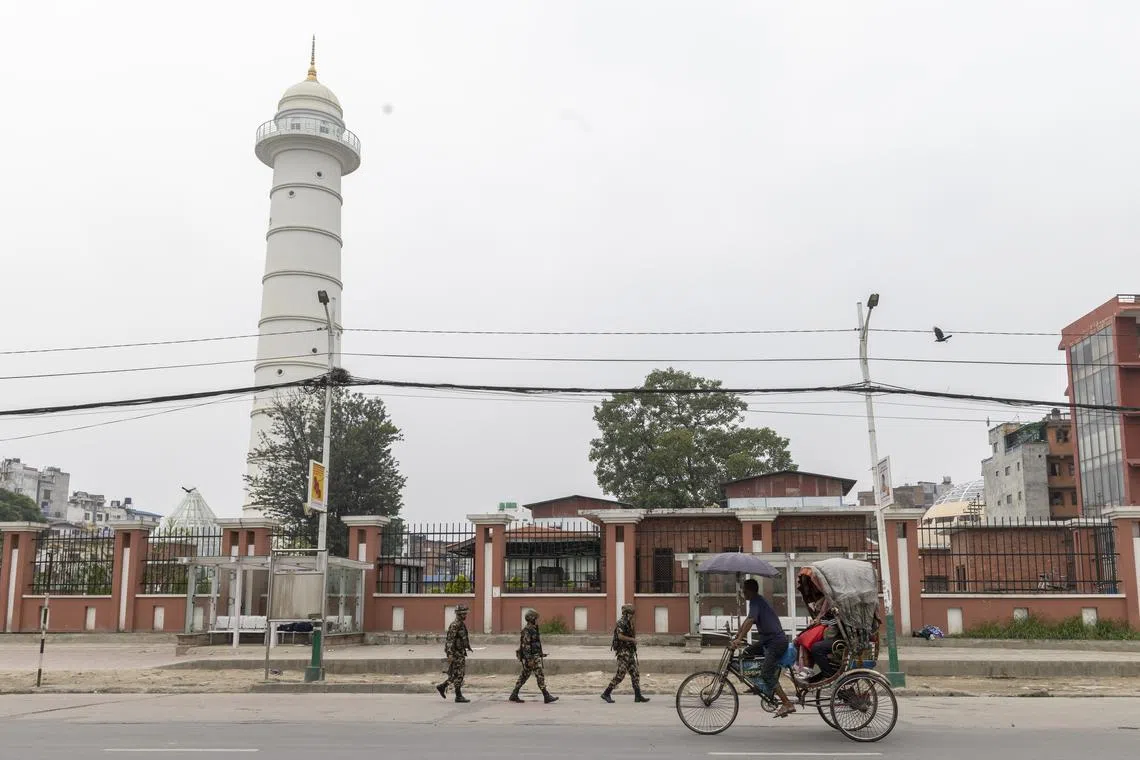Death toll of Nepal protests rises despite army deployment
Sign up now: Get ST's newsletters delivered to your inbox

The Nepalese Army patrols the streets in Kathmandu, Nepal, on Sept 10.
PHOTO: EPA
Follow topic:
KATHMANDU – The Nepali Army deployed troops on Kathmandu’s streets to contain violent unrest that forced the political leadership to step down,
The number of injured is over 1,000, The Hindu newspaper reported, citing Nepal’s Ministry of Health and Population as of Sept 10 evening.
The army deployment began on Sept 9 evening after Prime Minister K.P. Sharma Oli resigned, as protesters stormed his office and set fire to his private residence and other government buildings.
The first wave of protests was sparked by a ban on some popular social media platforms, and escalated on Sept 9 as demonstrators demanded action against poor governance.
The airport in the capital remains shut, local media reported.
The Himalayan nation is the latest in the South Asian region to be shaken by violent anti-government street protests, driven largely by young people. In 2024, demonstrations in Bangladesh culminated in the ouster of longtime leader Sheikh Hasina, while in 2022 Sri Lanka’s government also fell amid mass unrest.
Alongside Mr Oli, several key ministers have also quit amid criticism of the government’s violent response to the protests, creating a political void in the country.
Analysts said the rising instability in the country could be a headache for India.
“India and Nepal remain bound by deep economic, security and cultural ties,” wrote Mr Chetna Kumar, Bloomberg’s geoeconomics analyst for South Asia. “Their open border makes Nepal’s stability directly relevant to India’s internal security.”
Nepal is strategically positioned between India and China and holds vast hydropower potential. Under Mr Oli, it drew closer to Beijing and New Delhi will be keen to contain its rival’s influence in the region.
The political unrest was triggered when Nepal’s government last week banned several social media platforms that had failed to register with the government, including Facebook, X and YouTube.
The government had said the new regulations would prevent fake news, hate speech and cybercrimes. Protesters said the restrictions reflect the government’s authoritarian attitude and accused it of failing to tackle widespread corruption.
The protests also reflect deeper frustrations among Nepal’s youth over joblessness and inequality. Terms like “nepo kids” have been trending widely on social media posts related to the protests – used to derisively describe the trend of children of elites flaunting their wealth.
More than 20 per cent of the country’s 30 million people live in poverty, according to the World Bank, while the most recent official figures estimate youth unemployment at 22 per cent. BLOOMBERG

